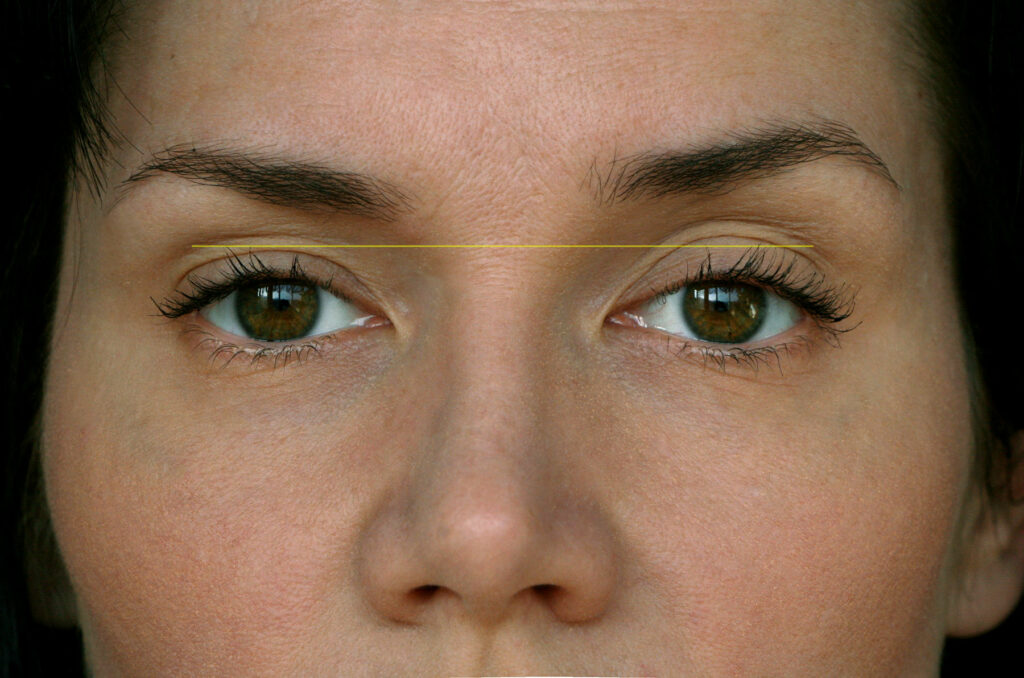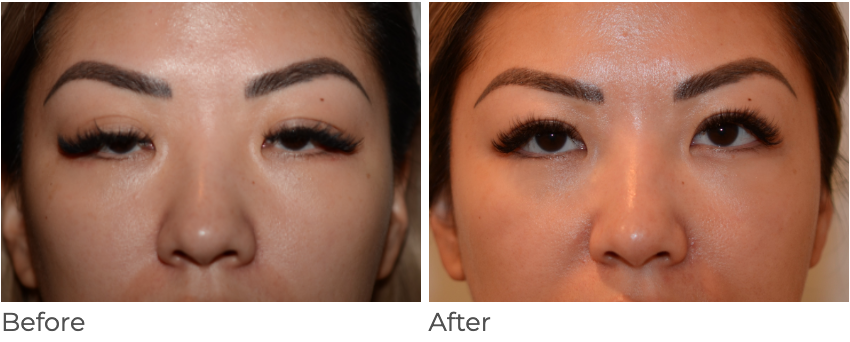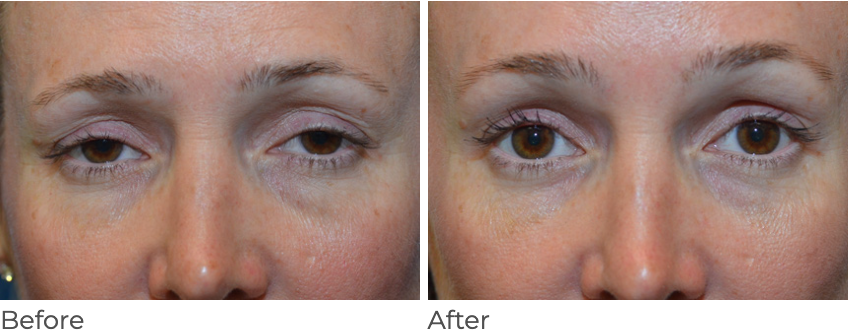
Eyelid Ptosis Repair: Questions and Answers
What,” you may be asking yourself, “is eyelid ptosis?” Ptosis (pronounced “toe-sis,” short for blepharoptosis) is a condition in which the upper eyelid droops over the eye. Ptosis can occur in both children and adults and can be due to genetics, medical conditions that affect the nerves in the eyelid, trauma to the eye/eye socket, and most commonly, aging.
There are varying degrees of ptosis, in some cases it is only cosmetic but in others the eyelid can droop as far as to cover the pupil, obstructing vision. Ptosis in children is usually congenital and often is a result of issues with the levator muscle, used to lift the eyelid. Children with untreated ptosis that interferes with vision can develop other problems including amblyopia–also known as a “lazy eye”– astigmatism or crossed eyes.
Some people with ptosis may compensate by arching their eyebrows or tilting the head backwards or to the side, which can result in long-term neck and shoulder issues. In some severe cases, the sufferer may be required to physically lift their eyelids to allow them to see clearly.
Eyelid ptosis is a very common condition that can contribute to other health issues but luckily, there is a surgical fix that we, at Amadi, are proud to offer. Eyelid ptosis repair is an effective solution for those experiencing the negative medical effects of eyelid ptosis, and for those with early-stage ptosis who wish to prevent the possibility of the condition worsening over time.
What causes ptosis?
There are many causes of ptosis including age related weakening of the muscle, congenital weakness, trauma, or sometimes neurologic disease. As we age, the tendon that attaches the levator muscle, the major muscle that lifts the eyelid, can stretch or slip which causes the eyelid to fall. This represents the most common cause of a droopy eyelid, and can be exacerbated or hastened by contact lens wear over several years. Ptosis may also occur following routine lasik or cataract surgery due to stretching of the muscle or tendon. Children may be born with ptosis or may acquire it due to trauma or neurologic reasons.
How can ptosis be corrected?
Ptosis can be corrected surgically and usually involves tightening one of the muscles that elevate the eyelid (Levator or Muller’s muscle). The surgical repair may be performed through a skin incision along the eyelid crease (levator advancement), or more alternatively, by flipping the eyelid inside out, and tightening the muscle from the back side of the eyelid (Muller’s muscle shortening), thus avoiding an external scar.
In severe ptosis, when the levator muscle is extremely weak, a “sling” operation may be performed, enabling the forehead muscles to elevate the eyelid(s).
Whether your procedure will be done under local or general anesthetic will depend on your individual situation, and the approach your doctor decides is best for your condition.

Ptosis surgery recovery:
You will likely experience some moderate to severe bruising and swelling which should subside after the initial healing period of one week to ten days. Your doctor will schedule a follow-up appointment to observe your progression and to remove your sutures after one week. It is not uncommon to experience some mild swelling for up to two months post-op, but you should be mostly healed by three months. Some patients experience difficulty closing their eyes after surgery due to swelling, if this is the case, your doctor will prescribe drops and/or ointment to prevent infection and chronic dry eye while the swelling subsides.
What are the risks and complications of ptosis repair?
When ptosis repair is performed by an experienced and knowledgeable surgeon, the risk of complication is significantly diminished. However, as with any surgery risks still exist. These include:
- Dry eye
- Poor blink
- Eyelid asymmetry
- Eyelid retraction
- Excessive tearing
- Loss of vision (extremely rare)
Some patients are unable to fully close their eyelids post surgery, but this is usually due to swelling and corrects itself over the following weeks.
Ptosis surgery is one of the most challenging surgeries done by Oculofacial plastic surgeons, and need for revision surgery is not uncommon (about 10-20%). For this reason, it is very important to find a board-certified Oculofacial plastic surgeon with extensive experience and specialization in eye procedures, such as Dr. Amadi.
Because of his expertise in this area, many other plastic surgeons refer patients with complications of eyelid surgery to Dr. Amadi for treatment and repair.
Am I a candidate?
If you suffer from ptosis, and you and your eyelid are healthy, generally you are a candidate for ptosis surgery. If you suffer from moderate to severe dry eye, it may not be recommended for you to undergo ptosis surgery as elevating the eyelid can exacerbate these symptoms.
When you come in for your consultation, Dr Amadi will do an assessment and examine your eyes for any underlying condition that may be causing your ptosis.
These include:
- Tumors
- Diabetes
- Stroke
- Horner syndrome – the disruption of a nerve pathway from the brain to the face and eye on one side causing a decrease in pupil size, ptosis and a decrease in sweating on the affected side.
- Myasthenia Gravis – the weakness and fatigue of muscles under voluntary control, frequently those of the eye.
Dr. Amadi will also perform testing to determine the best form of correction for the individual patient. The goal is to elevate the eyelid to permit a full field of vision and to achieve symmetry with the opposite upper eyelid while minimizing risks of surgery.
What is the difference between ptosis repair and blepharoplasty?
While these two procedures are often confused and generically termed “eyelid lift”, upper blepharoplasty addresses loose or excess eyelid skin and/or prolapsed fat, while ptosis repair is the tightening of the deep upper eyelid muscles that elevate the entire eyelid, and is not related to the excess eyelid skin.
Blepharoplasty can be performed on the upper and lower lid. Upper blepharoplasty involves the removal of excess skin from the upper eyelid, while in lower blepharoplasty, excess fat is removed or relocated to eliminate the appearance of hollowness below the eyes. In both upper and lower blepharoplasty, the eyelids remain at the same height but the removal of excess skin and fat results in a brighter, more alert appearance.
In ptosis repair the height of the eyelid is altered. This will improve both vision and appearance, making the eye appear larger while enhancing the patient’s overall quality of life.
If you are unsure which procedure is right for you, Dr. Amadi will guide you at your consultation.
Before and After: Ptosis Repair Surgery


See more Ptosis Repair Surgery Before and After
Will my insurance cover ptosis repair?
We wish there was a straight answer to this question. If your ptosis is interfering with your vision and significantly affecting your overall well-being, this is a case for some insurance companies to cover your procedure. However, each insurance company has different policies and it can be difficult to persuade some that this is a quality-of-life-procedure and not a voluntary, aesthetic one. If the eyelid droop is compromising the superior visual field, this will need to be confirmed by a formal visual field test. If the visual field test AND photographs demonstrate that the ptosis is severe enough, your surgery may be pre-approved.
Unfortunately, this will take additional time, and is sometimes fraught with bureaucratic difficulties. Due to all these factors, Dr. Amadi is out of network with all insurance companies, except Medicare, but he is an out-of-network provider for most major insurance companies. This means that you would be responsible for payment, but can submit for reimbursement from your insurance company if you have out-of-network privileges. We will do our best to streamline this process by providing diagnosis/surgery codes and invoicing for submission. We understand how necessary this procedure can be in helping you live your life to the fullest!
Click here to learn more about Ptosis Repair Surgery.
Amadi Plastic Surgery
Lorem ipsum dolor sit amet, consectetur adipiscing elit. In nec erat in nibh pellentesque vestibulum eget eu massa. Lorem ipsum dolor sit amet,